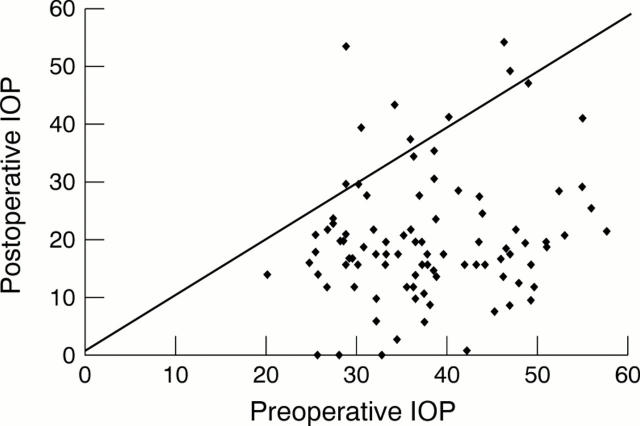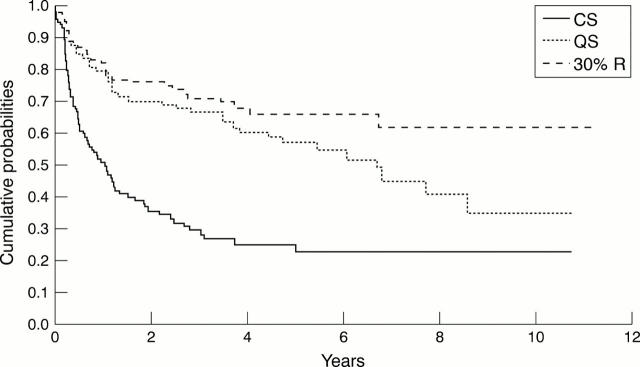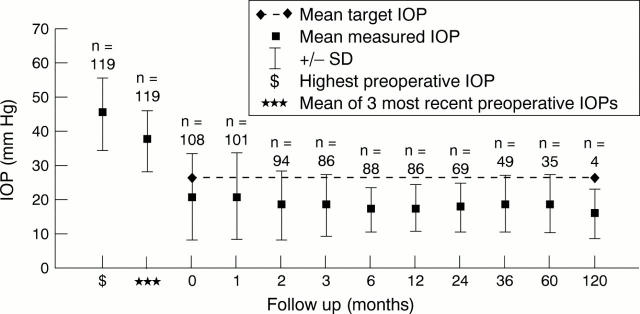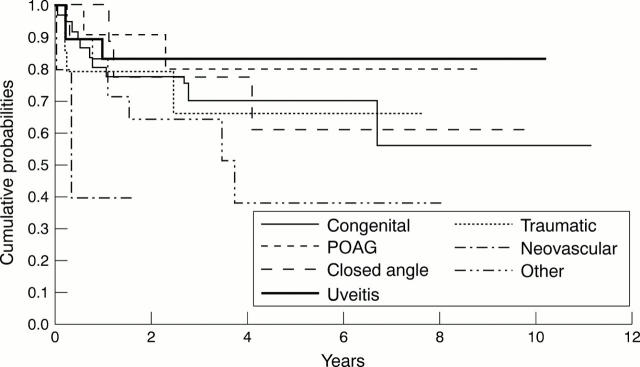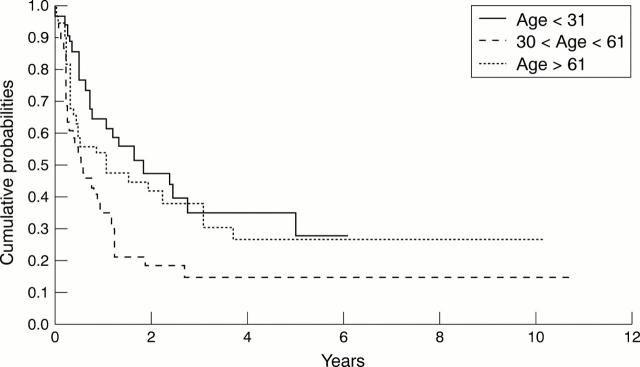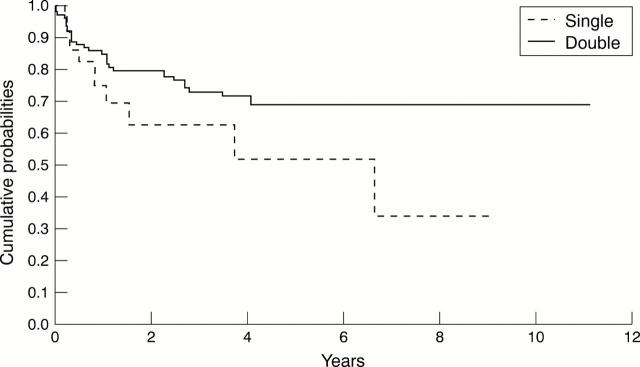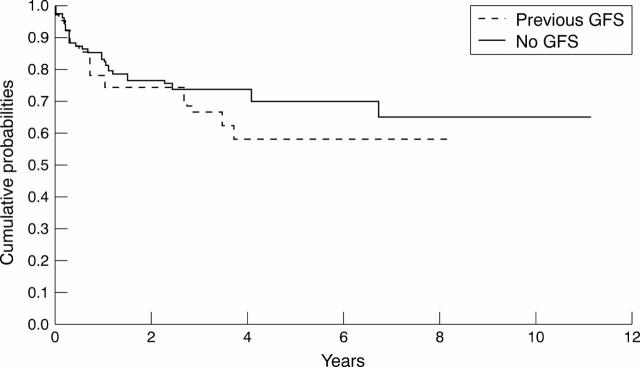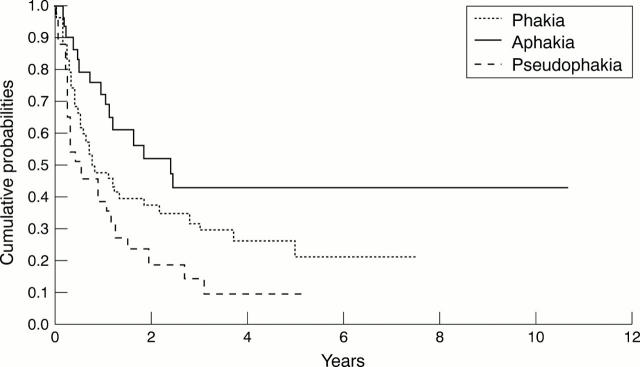Abstract
AIM—To apply survival analysis in assessing the long term outcome of Molteno tube implantation and to identify risk factors for failure. METHODS—A retrospective, 10 year, consecutive case series study of 119 eyes that underwent implantation of a Molteno tube. The main outcome measures considered were intraocular pressure (IOP), visual acuity, and complications. RESULTS—A 30% or greater reduction in IOP was achieved in 68.9% of cases. However, the overall, "complete success" rate (IOP <22 mm Hg with no medications) after a mean (SD) follow up period of 43 (33) months (range 6-120) was only 33.6% despite a fall in mean (SD) IOP from 38.2 (8.2) mm Hg to 20.1 (11.0) mm Hg. The "qualified success" rate (IOP <22 mm Hg with or without medications) was 60.5%. Failure was most common in the first postoperative year but could occur after several years, the survival curve having an exponential shape. The only statistically significant risk factor for failure identified was pseudophakia, although eyes with neovascular glaucoma tended to fare poorly. Postoperative IOP tended to be lower after double plate than after single plate implantation. There was no significant difference in outcome based on age, sex, race, previous penetrating keratoplasty, or previous conjunctival surgery. CONCLUSIONS—In eyes at high risk of trabeculectomy failure, implantation of an aqueous shunt device should be considered. Pseudophakia should be considered an additional risk factor for failure. Early failure appeared relatively more common but long term follow up of all cases is recommended to ensure adequate management of late failures.
Full Text
The Full Text of this article is available as a PDF (160.5 KB).
Figure 1 .
Scatter plot of mean preoperative intraocular pressure (IOP) against final postoperative IOP for all eyes. Some points overlie others and may represent more than one case. The oblique line of no change in IOP is drawn to show that there was a reduction in IOP for the majority of cases.
Figure 2 .
Kaplan-Meier survival curves for all patients, plotting the cumulative probabilities against time that (i) the intraocular pressure (IOP) remains below 22 mm Hg without additional medical treatment ("complete" success: CS), (ii) the IOP remains below 22 mm Hg with or without additional medical treatment ("qualified" success: QS); and (iii) the IOP remains below the target IOP (set as a 30% reduction from the mean preoperative IOP; -30%R) following tube implantation.
Figure 3 .
Intraocular pressure (IOP) versus time profile for the whole patient group. The first point represents the highest recorded preoperative IOP levels and the second point the mean of the three most recent preoperative IOP values. The other points represent the mean IOP values for the appropriate postoperative time point.
Figure 4 .
Kaplan-Meier survival curves based on diagnostic category, plotting the cumulative probabilities against time that intraocular pressure (IOP) remains below the target IOP (set as a 30% reduction from the mean preoperative IOP) following tube implantation. POAG = primary open angle glaucoma.
Figure 5 .
Kaplan-Meier survival curves based on age group (0-30 years, 31-60 years, 61-91 years), plotting the cumulative probabilities against time that intraocular pressure (IOP) remains below 22 mm Hg without additional medical treatment ("complete" success) following tube implantation.
Figure 6 .
Kaplan-Meier survival curves based on type of Molteno tube implanted (single v double plate), plotting the cumulative probabilities against time that intraocular pressure (IOP) remains below the target IOP (set as a 30% reduction from the mean preoperative IOP) following tube implantation.
Figure 7 .
Kaplan-Meier survival curves based on whether or not the eye had undergone previous glaucoma filtration surgery before tube insertion, plotting the cumulative probabilities against time that intraocular pressure (IOP) remains below the target IOP (set as a 30% reduction from the mean preoperative IOP) following tube implantation.
Figure 8 .
Kaplan-Meier survival curves based on lens status (phakia, pseudophakia, aphakia), plotting the cumulative probabilities against time that intraocular pressure (IOP) remains below 22 mm Hg without additional medical treatment ("complete" success) following tube implantation.
Selected References
These references are in PubMed. This may not be the complete list of references from this article.
- Addicks E. M., Quigley H. A., Green W. R., Robin A. L. Histologic characteristics of filtering blebs in glaucomatous eyes. Arch Ophthalmol. 1983 May;101(5):795–798. doi: 10.1001/archopht.1983.01040010795021. [DOI] [PubMed] [Google Scholar]
- Assaad M. H., Baerveldt G., Rockwood E. J. Glaucoma drainage devices: pros and cons. Curr Opin Ophthalmol. 1999 Apr;10(2):147–153. doi: 10.1097/00055735-199904000-00012. [DOI] [PubMed] [Google Scholar]
- Classen L., Kivelä T., Tarkkanen A. Histopathologic and immunohistochemical analysis of the filtration bleb after unsuccessful glaucoma seton implantation. Am J Ophthalmol. 1996 Aug;122(2):205–212. doi: 10.1016/s0002-9394(14)72011-2. [DOI] [PubMed] [Google Scholar]
- Folberg R., Hargett N. A., Weaver J. E., McLean I. W. Filtering valve implant for neovascular glaucoma in proliferative diabetic retinopathy. Ophthalmology. 1982 Mar;89(3):286–289. doi: 10.1016/s0161-6420(82)34810-1. [DOI] [PubMed] [Google Scholar]
- Freedman J., Rubin B. Molteno implants as a treatment for refractory glaucoma in black patients. Arch Ophthalmol. 1991 Oct;109(10):1417–1420. doi: 10.1001/archopht.1991.01080100097051. [DOI] [PubMed] [Google Scholar]
- Heuer D. K., Lloyd M. A., Abrams D. A., Baerveldt G., Minckler D. S., Lee M. B., Martone J. F. Which is better? One or two? A randomized clinical trial of single-plate versus double-plate Molteno implantation for glaucomas in aphakia and pseudophakia. Ophthalmology. 1992 Oct;99(10):1512–1519. doi: 10.1016/s0161-6420(92)31772-5. [DOI] [PubMed] [Google Scholar]
- Kramer T., Brown R., Lynch M., Sternberg P., Jr, Buchek G., L'Hernault N., Grossniklaus H. E. Molteno implants and operating microscope-induced retinal phototoxicity. A clinicopathologic report. Arch Ophthalmol. 1991 Mar;109(3):379–383. doi: 10.1001/archopht.1991.01080030081044. [DOI] [PubMed] [Google Scholar]
- Lavin M. J., Franks W. A., Wormald R. P., Hitchings R. A. Clinical risk factors for failure in glaucoma tube surgery. A comparison of three tube designs. Arch Ophthalmol. 1992 Apr;110(4):480–485. doi: 10.1001/archopht.1992.01080160058030. [DOI] [PubMed] [Google Scholar]
- Law S. K., Kalenak J. W., Connor T. B., Jr, Pulido J. S., Han D. P., Mieler W. F. Retinal complications after aqueous shunt surgical procedures for glaucoma. Arch Ophthalmol. 1996 Dec;114(12):1473–1480. doi: 10.1001/archopht.1996.01100140671004. [DOI] [PubMed] [Google Scholar]
- Lee D., Shin D. H., Birt C. M., Kim C., Kupin T. H., Olivier M. M., Khatana A. K., Reed S. Y. The effect of adjunctive mitomycin C in Molteno implant surgery. Ophthalmology. 1997 Dec;104(12):2126–2135. doi: 10.1016/s0161-6420(97)30050-5. [DOI] [PubMed] [Google Scholar]
- Lloyd M. A., Baerveldt G., Nguyen Q. H., Minckler D. S. Long-term histologic studies of the Baerveldt implant in a rabbit model. J Glaucoma. 1996 Oct;5(5):334–339. [PubMed] [Google Scholar]
- Lloyd M. A., Sedlak T., Heuer D. K., Minckler D. S., Baerveldt G., Lee M. B., Martone J. F. Clinical experience with the single-plate Molteno implant in complicated glaucomas. Update of a pilot study. Ophthalmology. 1992 May;99(5):679–687. doi: 10.1016/s0161-6420(92)31910-4. [DOI] [PubMed] [Google Scholar]
- Loeffler K. U., Jay J. L. Tissue response to aqueous drainage in a functioning Molteno implant. Br J Ophthalmol. 1988 Jan;72(1):29–35. doi: 10.1136/bjo.72.1.29. [DOI] [PMC free article] [PubMed] [Google Scholar]
- Löffler K. U., Grehn F. Histologischer Vergleich zwischen funktionierender und nichtfunktionierender Filtrationsmembran beim Molteno-Implantat. Fortschr Ophthalmol. 1990;87(1):28–31. [PubMed] [Google Scholar]
- Mills R. P., Reynolds A., Emond M. J., Barlow W. E., Leen M. M. Long-term survival of Molteno glaucoma drainage devices. Ophthalmology. 1996 Feb;103(2):299–305. doi: 10.1016/s0161-6420(96)30700-8. [DOI] [PubMed] [Google Scholar]
- Minckler D. S., Heuer D. K., Hasty B., Baerveldt G., Cutting R. C., Barlow W. E. Clinical experience with the single-plate Molteno implant in complicated glaucomas. Ophthalmology. 1988 Sep;95(9):1181–1188. doi: 10.1016/s0161-6420(88)33029-0. [DOI] [PubMed] [Google Scholar]
- Molteno A. C. New implant for drainage in glaucoma. Clinical trial. Br J Ophthalmol. 1969 Sep;53(9):606–615. doi: 10.1136/bjo.53.9.606. [DOI] [PMC free article] [PubMed] [Google Scholar]
- Molteno A. C., Polkinghorne P. J., Bowbyes J. A. The vicryl tie technique for inserting a draining implant in the treatment of secondary glaucoma. Aust N Z J Ophthalmol. 1986 Nov;14(4):343–354. doi: 10.1111/j.1442-9071.1986.tb00470.x. [DOI] [PubMed] [Google Scholar]
- Omi C. A., De Almeida G. V., Cohen R., Mandia C., Jr, Kwitko S. Modified Schocket implant for refractory glaucoma. Experience of 55 cases. Ophthalmology. 1991 Feb;98(2):211–214. doi: 10.1016/s0161-6420(91)32315-7. [DOI] [PubMed] [Google Scholar]
- Perkins T. W., Cardakli U. F., Eisele J. R., Kaufman P. L., Heatley G. A. Adjunctive mitomycin C in Molteno implant surgery. Ophthalmology. 1995 Jan;102(1):91–97. doi: 10.1016/s0161-6420(95)31048-2. [DOI] [PubMed] [Google Scholar]
- Prata J. A., Jr, Mérmoud A., LaBree L., Minckler D. S. In vitro and in vivo flow characteristics of glaucoma drainage implants. Ophthalmology. 1995 Jun;102(6):894–904. doi: 10.1016/s0161-6420(95)30937-2. [DOI] [PubMed] [Google Scholar]
- Price F. W., Jr, Wellemeyer M. Long-term results of Molteno implants. Ophthalmic Surg. 1995 Mar-Apr;26(2):130–135. [PubMed] [Google Scholar]
- Rubin B., Chan C. C., Burnier M., Munion L., Freedman J. Histopathologic study of the Molteno glaucoma implant in three patients. Am J Ophthalmol. 1990 Oct 15;110(4):371–379. doi: 10.1016/s0002-9394(14)77017-5. [DOI] [PubMed] [Google Scholar]
- Skuta G. L., Parrish R. K., 2nd Wound healing in glaucoma filtering surgery. Surv Ophthalmol. 1987 Nov-Dec;32(3):149–170. doi: 10.1016/0039-6257(87)90091-9. [DOI] [PubMed] [Google Scholar]
- Susanna R., Jr, Nicolela M. T., Takahashi W. Y. Mitomycin C as adjunctive therapy with glaucoma implant surgery. Ophthalmic Surg. 1994 Jul;25(7):458–462. [PubMed] [Google Scholar]



